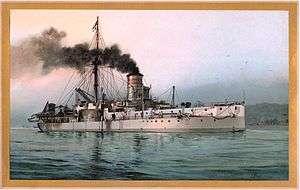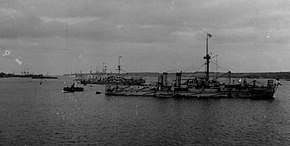SMS Württemberg (1878)
SMS Württemberg [lower-alpha 1] was one of four Sachsen-class armored frigates of the German Imperial Navy. Her sister ships were Sachsen, Bayern, and Baden. Württemberg was built in the AG Vulcan shipyard in Stettin from 1876 to 1881. The ship was commissioned into the Imperial Navy in August 1881. She was armed with a main battery of six 26 cm (10.2 in) guns in two open barbettes.
 Painting of SMS Württemberg | |
| History | |
|---|---|
| Name: | SMS Württemberg |
| Builder: | AG Vulcan in Stettin |
| Laid down: | 1876 |
| Launched: | 9 November 1878 |
| Commissioned: | 9 May 1881 |
| Fate: | Broken up, 1920 |
| General characteristics | |
| Class and type: | Sachsen-class ironclad |
| Displacement: | 7,677 t (7,556 long tons; 8,462 short tons) |
| Length: | 98.2 m (322 ft 2 in) |
| Beam: | 18.4 m (60 ft 4 in) |
| Draft: | 6.32 m (20 ft 9 in) |
| Installed power: | |
| Propulsion: |
|
| Speed: | 13 knots (24 km/h; 15 mph) |
| Range: | 1,940 nmi (3,590 km; 2,230 mi) at 10 knots (19 km/h; 12 mph) |
| Complement: |
|
| Armament: |
|
| Armor: | |
After her commissioning, Württemberg served with the fleet on numerous training exercises and cruises. She participated in several cruises escorting Kaiser Wilhelm II on state visits to Great Britain and to various cities in the Baltic Sea in the late 1880s and early 1890s. During 1898–1899, the ship was modernized at the Imperial Dockyard in Kiel; she served for another seven years with the fleet before being withdrawn from active service in 1906. She was subsequently used in a variety of secondary roles, until she was sold in 1920 and broken up for scrap.
Design
The Sachsen class was the first group of capital ships built under the tenure of General Albrecht von Stosch, the first Chief of the Imperial Admiralty. Stosch favored a coastal defense strategy for the German fleet, and the Sachsens were intended to operate from fortified ports, from which they could sortie to attack blockading fleets. They proved to be controversial in service, as critics pointed out their poor seakeeping, tendency to roll in heavy seas, and low speed compared to earlier armored frigates.[1]
The ship was 98.2 m (322 ft 2 in) long overall and had a beam of 18.4 m (60 ft 4 in) and a draft of 6.32 m (20 ft 9 in) forward.[2] Württemberg was powered by two 3-cylinder single-expansion steam engines, which were supplied with steam by eight coal-fired Dürr boilers. The ship's top speed was 13 knots (24 km/h; 15 mph), at 5,600 metric horsepower (5,500 ihp).[3] Her standard complement consisted of 32 officers and 285 enlisted men, though while serving as a squadron flagship this was augmented by another 7 officers and 34 men.[2]
She was armed with a main battery of six 26 cm (10.2 in) guns, two of which were single-mounted in an open barbette forward of the conning tower and the remaining four mounted amidships, also on single mounts in an open barbette. As built, the ship was also equipped with six 8.7 cm (3.4 in) L/24 guns and eight 3.7 cm (1.5 in) Hotchkiss revolver cannons for defense against torpedo boats.[2][4]
Württemberg's armor was made of wrought iron, and was concentrated in an armored citadel amidships.[5] The armor ranged from 203 to 254 mm (8 to 10 in) on the armored citadel, and between 50–75 mm (2–3 in) on the deck. The barbette armor was 254 mm of wrought iron backed by 250 mm of teak.[6]
Service history

Württemberg was ordered by the Imperial Navy under the contract name "D," which denoted that the vessel was a new addition to the fleet. She was built at the AG Vulcan shipyard in Stettin; her keel was laid down in 1876 under yard number 78.[3] The ship was launched on 9 November 1878 and was commissioned into the German fleet on 9 May 1881.[2] Along with her three sisters, Württemberg was the first large, armored warship built for the German navy that relied entirely on engines for propulsion.[5]
After her commissioning, Württemberg was placed in reserve. She was not activated for service with the fleet until 1884; this in part had to do with the poor performance of her sister Sachsen in the fleet maneuvers of 1880.[7] Among the problems associated with the Sachsen-class ships was a tendency to roll dangerously due to their flat bottoms, which greatly reduced the accuracy of their guns. The ships were also poorly armored, compared to their contemporaries. In addition, they were slow and suffered from poor maneuverability.[8] Nevertheless, Württemberg and her three sisters served as I Division in the 1884 fleet maneuvers, under the command of Rear Admiral Alexander von Monts.[7] The ship was again placed in reserve in 1885, but returned to fleet service in 1886 alongside Sachsen, Baden, and the new ironclad Oldenburg. During the annual fleet maneuvers, Württemberg's engines proved troublesome.[9]
Following the 1886 maneuvers, Württemberg and her three sisters were removed from active duty to serve as the Baltic reserve division. In June 1887, Germany dedicated the Kaiser Wilhelm Canal; Württemberg was among the ships present during the celebrations.[10] The ship returned to active service with the fleet in 1890 when she joined I Division during the annual maneuvers. Württemberg was commanded by Captain Alfred von Tirpitz during the exercises. The eight ships of I and II Divisions simulated a Russian fleet blockading Kiel, which was defended by torpedo boat flotillas.[11] Württemberg was in reserve during the 1891 maneuvers, but returned to I Division in 1892, 1893, and 1894.[12] By the winter of 1894–1895, the last of the four Brandenburg-class battleships had been commissioned; these ships were assigned to I Division, which displaced Württemberg and her three sisters to II Division. The eight ships conducted training cruises over the winter and spring before conducting the annual autumn fleet exercises.[13]

On 21 June 1895, the Kaiser Wilhelm Canal was opened for traffic, eight years after work had begun. Württemberg and her three sisters, along with dozens of other warships, attended the ceremonies. The major naval powers sent fleets to join the fleet review.[14] The Autumn 1895 maneuvers simulated a high-seas battle between I and II Divisions in the North Sea, followed by combined maneuvers with the rest of the fleet in the Baltic.[15] Württemberg again served during the 1896 and 1897 maneuvers, though Sachsen was her only sister to join the exercises. Baden and Bayern were out of service for extensive modernization.[16]
After the conclusion of the 1897 maneuvers, Württemberg was taken into drydock at the Imperial Dockyard in Kiel for reconstruction.[2] The ship's old wrought iron and teak armor was replaced with new Krupp nickel-steel armor.[17] The four funnels were trunked into a single large funnel and new engines were also installed,[4] which increased the ship's speed to 15.4 knots (28.5 km/h; 17.7 mph). The ship's 8.7 cm guns were replaced with quick-firing 8.8 cm (3.5 in) SK L/30 guns and four 3.7 cm (1.5 in) autocannons. Work was completed in 1898. Württemberg remained with the fleet until 1906;[2] her replacement in the fleet organization plan, the new dreadnought battleship Rheinland, was ordered that year.[18] Württemberg was then used as a torpedo training and test ship until February 1919, when she was reduced to an escort for F-type minesweepers. The ship was stricken from the naval register on 20 October 1920 and sold to Hattinger Co. Württemberg was ultimately broken up for scrap in Wilhelmshaven.[2]
Notes
- "SMS" stands for "Seiner Majestät Schiff", or "His Majesty's Ship".
- Dodson, pp. 23–25.
- Gröner, p. 8.
- Gröner, pp. 7–8.
- Gardiner, p. 245.
- Hovgaard, p. 111.
- Gröner, p. 7.
- Sondhaus, p. 161.
- Sondhaus, pp. 135–136.
- Sondhaus, pp. 162–163.
- Sondhaus, p. 171.
- Sondhaus, p. 192.
- Sondhaus, pp. 194–196.
- Sondhaus, p. 198.
- Sondhaus, p. 199.
- Sondhaus, p. 201.
- Sondhaus, pp. 219–221.
- Sondhaus, p. 219.
- Gröner, p. 23.
References
- Dodson, Aidan (2016). The Kaiser's Battlefleet: German Capital Ships 1871–1918. Barnsley: Seaforth Publishing. ISBN 978-1-84832-229-5.
- Gardiner, Robert, ed. (1979). Conway's All the World's Fighting Ships 1860–1905. Greenwich: Conway Maritime Press. ISBN 978-0-8317-0302-8.
- Gröner, Erich (1990). German Warships: 1815–1945. Vol. I: Major Surface Vessels. Annapolis: Naval Institute Press. ISBN 978-0-87021-790-6.
- Hovgaard, William (1971). Modern History of Warships. London: Conway Maritime Press. ISBN 978-0-85177-040-6.
- Sondhaus, Lawrence (1997). Preparing for Weltpolitik: German Sea Power Before the Tirpitz Era. Annapolis: Naval Institute Press. ISBN 978-1-55750-745-7.